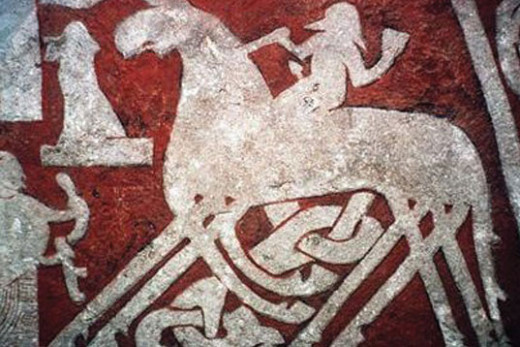The Many Origins of Santa Claus

The Holly Jolly Old Guy
The modern holiday icon is known by many names around the world: Santa Claus, Kris Kringle, Father Christmas, Pere Noel, and more. He is the night-flying, gift-giver, the jolly figure in red and white that delivers presents for children on Christmas eve. But what are the origins of this mysterious northern-dwelling figure? They're more varied than you'd think.

Odin and the Wild Hunt
Prior to Christianity, Yule was celebrated across much of Germania. It was the Winter Solstice and during this cold time, the god Odin was said to ride across the night sky on his eight-legged horse Sleipir on what was called the Wild Hunt. In various lore, the Wild Hunt consisted of the dead, faeries, or phantom huntsmen all decked out for a wild spectral ride across the sky.
In Scandinavia, it was said that when Odin's hunt was heard, it could foretell the changing in weather, which possibly ties into the Winter Solstice and the return of longer days. In some traditions of Odin's Yule ride, he would reward children that would leave treats for Sleipnir in their boots with candies, food, or other gifts.
This tradition still continues in Belgium, Germany, and the Netherlands. In other parts, like the US, this has been replaced with hanging stockings.

Saint Nicholas
Saint Nick, being one of the more well-known monikers, harkens back to Saint Nicholas of Myra, who was a 4th century bishop from Turkey. He was well known for his generosity, often donating dowries to poor families and giving gifts to children. In the middle ages, December 6 was his day, but during the Reformation, it was moved to align with December 25 and Christmas. Martin Luther was at the forefront of turning Christmas into a day of gift-giving for children to being them closer to Christ and wanted less focus on the venerating of saints. Nonetheless, Saint Nicholas of Myra's remains are still kept in two sacred locations - one in Venice and one in Bari.

Flying Reindeer
According to one theory, Santa and his flying reindeer can be traced back to some regions of Siberia and the use of magic mushrooms, or amanita muscaria. Reindeer often eat this red and white spotted mushroom (found growing coincidentally under pine trees) and while on their magic mushroom trip will prance and hop about, appearing as though trying to fly. Further cementing this possibility, shamans would consume the urine of reindeer who had eaten this mushroom and attain a psychedelic experience of their own.
It is also probable that the tradition of Santa entering through the chimney may have originated in the same region, as snow would fall so heavily as to block doorways and tent openings, and the only way in was through the top or "chimney".
A number of pagan deities associated with Yule or the Winter Solstice are also said to have ridden chariots pulls by white steeds or even goats, so this may have contributed to the origin of Santa's flying reindeer as well.

What about the Elves?
Elves have a long and fascinating history associated with many cultures, least of all Germanic pagans, to whom elves were small human-like creatures, male or female, that had magical powers and were immortal. In Scandinavia, they were house gnomes who would do good deeds if you were good to them and really mess you up if you weren't, but it wasn't until the mid-1800's that Scandinavian writers began associating elves as being helpers of Father Christmas. Thus, their new role as Santa's Helpers began.
Santa's elves are said to build toys and assist with preparing for Christmas and this harkens back to elves and gnomes being traditionally builders and cobblers in mythology and folklore around Europe.
The Tomte is a Swedish elf associated with Yule and is said to be around 3 feet tall, with a long white beard, and a conical hat. He finds his origins also as a protector of a home or "tomt" before Christianity - if treated well he rewards the family of the home and if not....mischief ensues. The tomte himself has been compared to Santa Claus rather than an elf helper though.

Quick Poll
Did you believe in Santa Claus as a child?
Jolly Red and White
While we can definitely point to the Shaman and amanita muscaria for the possible origin of Santa's red and white look, it wasn't until the 1930's that Coca-Cola began distributing the image of a jolly and rotund bearded man in the now iconic red suit trimmed with white fur that it really gained a lot of visual traction. While true that many writers over the years contributed to Santa Claus' image (Washington Irving, to name only one) it is Coke's iconic depiction that has cemented Father Christmas in his modern form the world over.

In Summary
There are a lot of conflicting theories on the origin of today's Santa Claus, but it can be said for certain that the Kris Kringle we know today as the spirit of Christmas is an amalgamation of so many different cultures, traditions, and superstitions that no one can claim him as their own. That's the beauty of Father Christmas, his magic is for everyone, regardless of nation or age.
Merry Christmas or Happy Holidays!

Sources
http://www.theholidayspot.com/christmas/history/elves.htm
http://www.snopes.com/holidays/christmas/santa/cocacola.asp
www.livescience.com/25731-magic-mushrooms-santa-claus.html
https://en.wikipedia.org/wiki/Santa_Claus
9gag.com/gag/aeN4Qjb/irrefutable-proof-that-santa-is-odin








